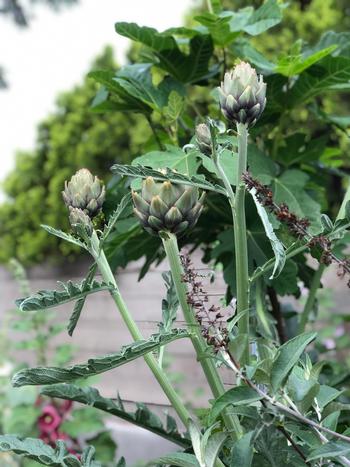Artichokes
Artichokes Basics
Artichokes are perennial (annual in low desert regions) cool-season vegetables with silver-green foliage. The bud, or immature flower, is the part of the artichoke that is harvested. The edible portions of the bud are the tender bases of the leaves (bracts), and the fleshy base upon which the flowers are borne (heart).
- Grow: from plant division, crowns or seed
- Zones: 3-11
- Light: full sun
- Plant spacing: 4-6 feet
- Plant size: 3-4 feet tall and 6 feet diameter
- Fertilization: spring/fall
- Watering: 1-2 times a week
- Days to harvest: 100-150 days
Note: The above plant characteristics are based on averages, for specific information on a specific plant variety or your garden zones, reference plant labels and/or seed packets.
Recommended varieties:
- Emerald
 Artichokes in UC Master Gardener Donna Palmer's home vegetable garden located in San Bernardino County. Photo credit: Donna Palmer
Artichokes in UC Master Gardener Donna Palmer's home vegetable garden located in San Bernardino County. Photo credit: Donna Palmer - Green Globe
- Imperial Star (spineless, for annual cropping)
Perennial plantings
The globe artichoke is commonly a perennial cool-season vegetable that yields and produces best when grown near or along the California coast where cool to mild climates prevail; Castroville, California, is known as the artichoke capital of the world.
Perennial plantings are not recommended in areas where warm to hot temperatures are common. Shading and mist irrigation may help vegetative growth, but warm growing conditions tend to toughen bud scales, reduce palatability, and produce poor yields. Frosts damage outer portions of the buds; severe or frequent frosts damage or kill the plants. If correctly cared for, you can maintain production in a plant for 5 years or more.
Use rooted offshoots or divisions from mature plants to propagate Green Globe. The other varieties may be obtained from seed or transplants. Plants establish better if you transplant shoots, root divisions, or transplants in the early fall so that the plants become well-rooted and of reasonable size before temperatures cool during the winter. Production starts about a year after planting, although some buds usually develop the first spring after early-fall plantings.
Once the plant is in a normal cycle, bud production starts in the fall. A small number of buds develop during the winter, but cold temperatures limit plant growth. The edible parts are the immature, scaly flower buds and bracts (leaves), along with the heart. The buds are said to contain a chemical that makes food eaten after them taste sweet. Mature artichoke flowers are a brilliant sky blue color, but they are not edible.
To harvest, cut the bud together with 2 to 3 inches of stem. This length of the stem is usually tender and edible. A mature plant produces 10 or more stems during a season; each stem can provide four to five buds.
A recommended cultural procedure is to cut the entire plant down to the soil level or slightly below it after the spring production peak. Then, reduce or withhold irrigation for several weeks. This allows for summer dormancy. Once you resume irrigation, it encourages rapid and vigorous regrowth of leaves and, shortly thereafter, new stems bearing new buds will develop for the fall production period.
Annual plantings for inland valleys and low desert regions
It is possible to grow high-quality artichokes in the inland valleys and low desert regions of southern California by handling them as a direct-seeded or transplanted annual crop. Until recently, it was believed that artichoke buds produced from seed-propagated plants were of inferior quality to those produced by vegetative propagation.
Research at the University of California, however, has shown that seed-initiated artichokes look and taste just as good as those produced vegetatively. Annual cropping makes growing artichokes feasible in gardens with limited space because the crop does not require long-term space allocation. Quicker rotation with other vegetables is also possible.
To grow artichokes in warm inland climates, plant seed or transplants of Imperial Star or Emerald in July for inland valley locations or in September for low deserts. Production can be expected anytime between January and April, as dictated by local climate.
| Problem Diagnosis for Artichokes | ||
| Problem | Probable cause | Comments |
| Holes, discoloration on bracts, stems, leaves. Caterpillars may be visible. |
artichoke plume moth | Cut plants down to ground level once per year. Chop and cover cuttings with 6 in of soil. Remove thistle. |
| Sticky exudate on chokes. Black, sooty mold. |
aphids |
Consider non-chemical controls first as aphids seldom kill mature plants. This can be pruning of affected area, dislodging aphids with a strong spray of water, and removing weeds that may be supporting the aphid population. |
| Blackening of choke surfaces. Jagged holes in leaves, stems. |
snails and slugs | Use commercial snail bait. Put mushrooms in garden as attractant. Use flashlight; collect and kill any found. Apply copper banding as a barrier around beds. |
| Curled leaves, dwarfed plant. Small, misshaped chokes. Reduced yield. |
curly dwarf virus | Remove and destroy infected plants immediately. Use noninfected stock for new plants. Remove milkthistle because it is an alternate host. |
| Gray or brown fungus growth. | Botrytis fungus | Common in rainy weather. Remove infected plant parts. |

